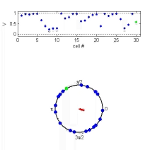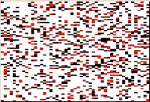| Description | Participants | Agenda | Resources | Products |
|---|
NIMBioS Investigative Workshop
Synchronous Activity in Biological Systems

Topic: Synchrony in Biological Systems Across Multiple Scales
Meeting dates: April 11-13, 2011
Organizers:
Alan Hastings (Environmental Science and Policy, Univ. of California, Davis, CA)
Tim Lewis (Dept. of Mathematics, Univ. of California, Davis, CA)
Michael Bonsall (Dept. of Zoology, Univ. of Oxford, Oxford, UK)
Objectives. Synchronous oscillatory activity and phase-locking in general are universal phenomena that occur in biological systems ranging from the level of intracellular dynamics to population dynamics across thousands of kilometers. The study of synchrony from a mathematical standpoint has had a very long history going back at least as far as Huygens in the 1600's. However, there are still many unanswered questions involving synchronization that are of central biological importance. The importance of synchrony in many different fields of biological and physical sciences has led to large bodies of literature on synchrony that have little cross-referencing. This workshop brought together a diverse group of researchers from mathematics and statistics and the biological sciences including ecology and neuroscience. We explored how ideas about the study of synchrony in one field can provide novel insights into questions of synchrony in another field. We also identified what are real gaps in the theory of synchrony from a biological perspective and identified where progress is possible.
Click here for more information on workshop's central theme.
Evaluation report (PDF)
Resources
Presentations
Overview: What Is Synchrony? (Alan Hastings)
Synchrony & Ecological Dynamics (Michael Bonsall)
Synchrony, Phase-Shift Synchrony, and Synchony-Breaking (Marty Golubitsky)
Spatio-Temporal Statistics (Noel Cressie)
Synchrony in Neural Systems (Tim Lewis)
Movies (click images below to play):

|

|

|
| Fast excitatory synapses (33 sec) | Slow excitatory synapses (50 sec) | Topological target patterns (40 sec) |

Summary. TBA
Background Reading (and Viewing) Material
Steven Strogatz on Sync (20 minute video). Mathematician Steven Strogatz shows how flocks of creatures (like birds, fireflies and fish) manage to synchronize and act as a unit -- when no one's giving orders. The powerful tendency extends into the realm of objects, too.
Liebhold, A., W. D. Koenig, et al. (2004). Spatial synchrony in population dynamics. Annual Review of Ecology, Evolution, and Systematics 35:467-490. [Download PDF]
M. A. Schwemmer and T.J. Lewis (2011) The Theory of Weakly Coupled Oscillators. Chapter in book: PRCs in Neuroscience: Theory, Experiment and Analysis (eds. N.Schultheiss, A.Prinz, R. Butera). Springer. (preprint) [Download PDF].
Strogatz, S. H. (2000). From Kuramoto to Crawford: exploring the onset of synchronization in populations of coupled oscillators. Physica D: Nonlinear Phenomena 143(1-4):1-20. [Online]
Stewart, I., M. Golubitsky, et al. (2003). Symmetry groupoids and patterns of synchrony in coupled cell networks. SIAM J. Appl. Dynam. Sys 2(4):609–646.
[Download PDF]
(Biologically oriented readers should skim this, rather than get lost in the details!)
Products
Publications
Gilman RT, Fabina NS, Abbott KC, Rafferty NE. 2012. Evolution of plant-pollinator mutualisms in response to climate change. Evolutionary Applications, 5(1): 2-16. [Online]
Logdberg F, Wennergren U. 2012. Spectral color, synchrony, and extinction risk. Theoretical Ecology, 5(4): 545-554. [Online]
Presentations
Cressie N. August 2011. Spatio-temporal statistics. CSIRO Workshop on Statistics for Spatio-Temporal Data, CSIRO, Canberra, Australia.
NIMBioS Investigative Workshops focus on broad topics or a set of related topics, summarizing/synthesizing the state of the art and identifying future directions. Workshops have up to 35 participants. Organizers and key invited researchers make up half the participants; the remaining participants are filled through open application from the scientific community. Open applicants selected to attend are notified by NIMBioS within two weeks of the application deadline. Investigative Workshops have the potential for leading to one or more future Working Groups. Individuals with a strong interest in the topic, including post-docs and graduate students, are encouraged to apply. If needed, NIMBioS can provide support (travel, meals, lodging) for Workshop attendees, whether from a non-profit or for-profit organization.
A goal of NIMBioS is to enhance the cadre of researchers capable of interdisciplinary efforts across mathematics and biology. As part of this goal, NIMBioS is committed to promoting diversity in all its activities. Diversity is considered in all its aspects, social and scientific, including gender, ethnicity, scientific field, career stage, geography and type of home institution. Questions regarding diversity issues should be directed to diversity@nimbios.org. You can read more about our Diversity Plan on our NIMBioS Policies web page. The NIMBioS building is fully handicapped accessible.
NIMBioS
1122 Volunteer Blvd., Suite 106
University of Tennessee
Knoxville,
TN 37996-3410
PH: (865) 974-9334
FAX: (865) 974-9461
Contact NIMBioS


